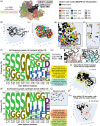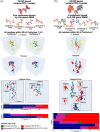MAGPIE: An interactive tool for visualizing and analyzing protein-ligand interactions
- PMID: 38989559
- PMCID: PMC11237554
- DOI: 10.1002/pro.5027
MAGPIE: An interactive tool for visualizing and analyzing protein-ligand interactions
Abstract
Quantitative tools to compile and analyze biomolecular interactions among chemically diverse binding partners would improve therapeutic design and aid in studying molecular evolution. Here we present Mapping Areas of Genetic Parsimony In Epitopes (MAGPIE), a publicly available software package for simultaneously visualizing and analyzing thousands of interactions between a single protein or small molecule ligand (the "target") and all of its protein binding partners ("binders"). MAGPIE generates an interactive three-dimensional visualization from a set of protein complex structures that share the target ligand, as well as sequence logo-style amino acid frequency graphs that show all the amino acids from the set of protein binders that interact with user-defined target ligand positions or chemical groups. MAGPIE highlights all the salt bridge and hydrogen bond interactions made by the target in the visualization and as separate amino acid frequency graphs. Finally, MAGPIE collates the most common target-binder interactions as a list of "hotspots," which can be used to analyze trends or guide the de novo design of protein binders. As an example of the utility of the program, we used MAGPIE to probe how different antibody fragments bind a viral antigen; how a common metabolite binds diverse protein partners; and how two ligands bind orthologs of a well-conserved glycolytic enzyme for a detailed understanding of evolutionarily conserved interactions involved in its activation and inhibition. MAGPIE is implemented in Python 3 and freely available at https://github.com/glasgowlab/MAGPIE, along with sample datasets, usage examples, and helper scripts to prepare input structures.
Keywords: biomolecular interactions; computational drug design; protein‐small molecule binding; protein–ligand interactions; protein–protein interactions.
© 2024 The Protein Society.
Figures






References
-
- Bentley JL. Multidimensional binary search trees used for associative searching. Commun ACM. 1975;18:509–517.
MeSH terms
Substances
Grants and funding
LinkOut - more resources
Full Text Sources
Research Materials

